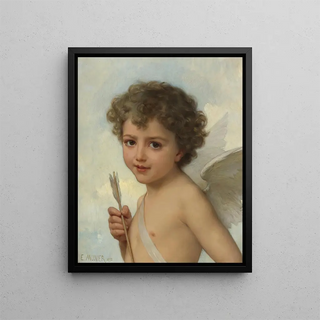Art print | Love - Émile Munier


View from behind

Frame (optional)
Émile Munier's "Love" artwork is a true ode to tenderness and the beauty of childhood. In this canvas, the artist manages to capture the very essence of pure love, the kind that emanates from innocent hearts. The scene depicts a young child, a symbol of innocence, surrounded by delicate flowers that seem to bloom under the gentle caress of love. The light, subtly balanced, illuminates the face of the young protagonist, revealing an expression that is both dreamy and mischievous. This painting, with its harmonious composition and atmosphere imbued with softness, invites the viewer to immerse themselves in a universe where love is king.
Style and uniqueness of the artwork
Munier, in this piece, stands out with his academic style, characterized by striking realism. Every detail, from the child's slight smile to the petals of the flowers, is rendered with meticulous precision. The colors, both vivid and delicate, create a striking contrast that draws the eye and captivates the soul. The artist uses a palette of pastel tones that evoke the softness of childhood, while infusing a certain warmth into the scene. The composition is carefully balanced, with each element arranged to guide the viewer's gaze toward the center of the work. This technical mastery, combined with palpable sensitivity, gives "Love" a timeless dimension, transcending eras and styles.
The artist and his influence
Émile Munier, a French painter of the 19th century, is often recognized for his ability to capture the innocence and beauty of children. His work is part of an artistic movement that values realism, but also emotion. Influenced by the great masters of his time, Munier developed a style that is uniquely his own, blending impeccable technique with sensitivity. His work has left an indelible mark on the art world, inspiring many contemporary artists. Through his paintings, he manages to establish a dialogue between the viewer and the artwork, inviting each to feel the emotions he has so skillfully translated onto the canvas. "Love" is

Matte finish

View from behind

Frame (optional)
Émile Munier's "Love" artwork is a true ode to tenderness and the beauty of childhood. In this canvas, the artist manages to capture the very essence of pure love, the kind that emanates from innocent hearts. The scene depicts a young child, a symbol of innocence, surrounded by delicate flowers that seem to bloom under the gentle caress of love. The light, subtly balanced, illuminates the face of the young protagonist, revealing an expression that is both dreamy and mischievous. This painting, with its harmonious composition and atmosphere imbued with softness, invites the viewer to immerse themselves in a universe where love is king.
Style and uniqueness of the artwork
Munier, in this piece, stands out with his academic style, characterized by striking realism. Every detail, from the child's slight smile to the petals of the flowers, is rendered with meticulous precision. The colors, both vivid and delicate, create a striking contrast that draws the eye and captivates the soul. The artist uses a palette of pastel tones that evoke the softness of childhood, while infusing a certain warmth into the scene. The composition is carefully balanced, with each element arranged to guide the viewer's gaze toward the center of the work. This technical mastery, combined with palpable sensitivity, gives "Love" a timeless dimension, transcending eras and styles.
The artist and his influence
Émile Munier, a French painter of the 19th century, is often recognized for his ability to capture the innocence and beauty of children. His work is part of an artistic movement that values realism, but also emotion. Influenced by the great masters of his time, Munier developed a style that is uniquely his own, blending impeccable technique with sensitivity. His work has left an indelible mark on the art world, inspiring many contemporary artists. Through his paintings, he manages to establish a dialogue between the viewer and the artwork, inviting each to feel the emotions he has so skillfully translated onto the canvas. "Love" is






